|
|

 Harriet Beecher Stowe and Uncle Tom's Cabin Harriet Beecher Stowe and Uncle Tom's Cabin  The Underground Railroad The Underground Railroad  The passing of the last of "The Great Triumvirate" The passing of the last of "The Great Triumvirate" The 1852 election The 1852 election The South attempts its own territorial expansion The South attempts its own territorial expansion The Kansas-Nebraska Act of 1854 The Kansas-Nebraska Act of 1854 The Congressional elections of 1854 The Congressional elections of 1854 The situation turns violent The situation turns violent  The 1856 election The 1856 election The Dred Scott Decision of 1857 The Dred Scott Decision of 1857 The Economic Panic of 1857 The Economic Panic of 1857  John Brown's raid on Harpers Ferry (October 1859) John Brown's raid on Harpers Ferry (October 1859) The textual material on this webpage is drawn directly from my work America – The Covenant Nation © 2021, Volume One, pages 274-285. |

|
|
Harriet Beecher Stowe's Uncle Tom's Cabin (1851–1852)
The answer to the question of how well the North was going to stand by its promise to enforce the Fugitive Slave Act came quickly in the form a broad reaction of Northerners to a piece of literature that took the North by storm: Harriet Beecher Stowe's Uncle Tom's Cabin. This story, first published as a periodical series in 1851 then as a novel in 1852, depicted the suffering and bravery of Southern slaves (most notably the slave Tom), the tragedy of the South caught in the trap of its own slavery system, and the power of Christian love to overcome evil. It was an immediate best-seller in the North,1 and moved the North vastly closer to the Abolitionist position. It also put the South again on the moral defensive,2 which in turn hardened Southern attitudes against the Union. As far as the Fugitive Slave Act of 1850 was concerned, the popularity of the novel fairly well undercut any idea of a serious enforcement of the Act in the North. In fact it merely encouraged yet another feature that had been developing on the American stage: the Underground Railroad. 1It sold 300,000 copies in the first year of its publication alone. 2It
was of course also read in the South, though interestingly with some
degree of sympathy – at least initially – until its strong political
implications became increasingly clear.
|

|
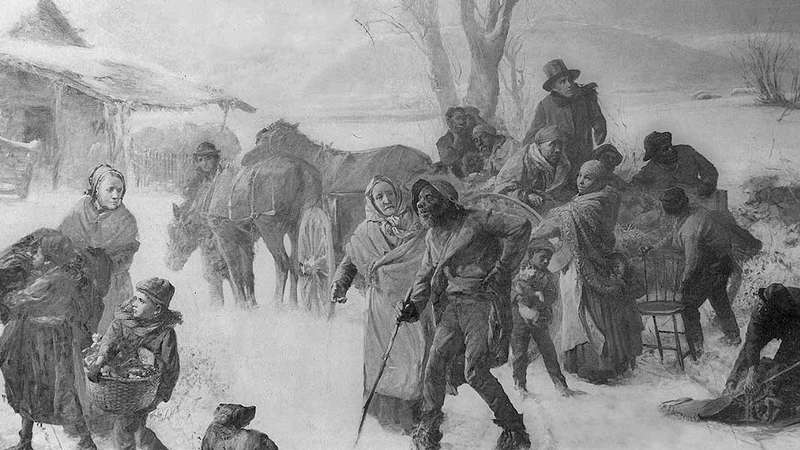
|
The Underground Railroad
The Underground Railroad was the term used in
reference to a system of aiding the escape of slaves from bondage to
freedom in either the Northern states or Canada. The system was neither
underground nor involving primarily a railroad, but was a complex
arrangement of safe houses where escaped slaves could hide and of
guides who would escort these escapees from one safe house to the
next. This process had actually been going on for quite some time. But during the period 1850 to 1860 its activity increased dramatically, though it is hard to know exactly how many slaves were moved North by this escape system, precisely because of its secret nature. Certainly, thousands made their way North. Both North and South were aware of its existence. Both sides claimed that it was extensive in nature, though the North would have cited huge numbers as a matter of pride in its accomplishments; and the South would have made a similar huge claim, though only to emphasize how great was the Northern violation of the agreed upon Fugitive Slave Act. The sight of Southern lawmen – but especially Southern bounty hunters – coming to Northern cities to look for just such escapees and under the authorization of the Fugitive Slave Act dragging them back into Southern slavery was more than Northern sensitivities could bear. Indeed, there was evidence that even free Blacks – and more horrifying, defenseless children – were simply kidnaped off the streets by Southerners seeking bounty money. This was pushing the North into the arms of the Abolitionists, Abolitionists who even recently had been declared by moderate Northerners as being dangerously radical. Now rather quickly, the Abolitionists were seeming less and less radical and more and more correct in their fierce opposition to slavery. The South, on the other hand, was outraged at the violent reaction of the Northerners to the Southern lawmen (and bounty hunters) who, under the full authority of the law, were simply in the North to recover the South's lost property. The South seethed in anger at how the North could so willingly violate the law of the land. So indeed, the Compromise of 1850 was turning out not to have achieved anything in the effort to settle the hostilities growing between the North and the South. If anything, it had succeeded merely in heightening and sharpening those hostilities.
|
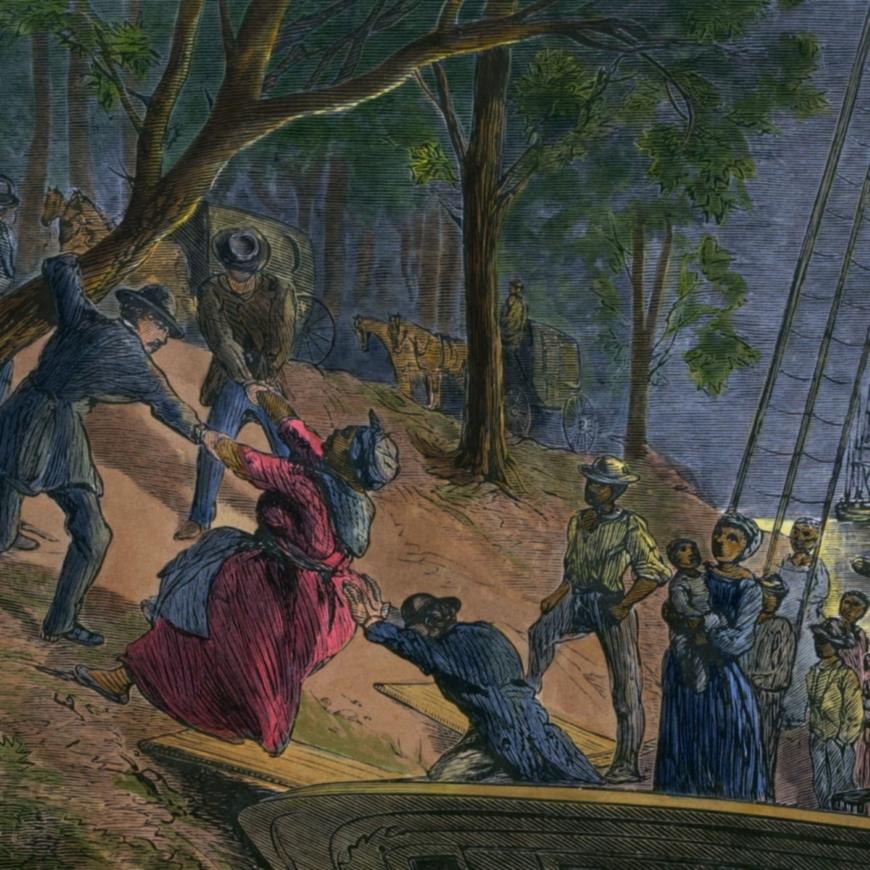
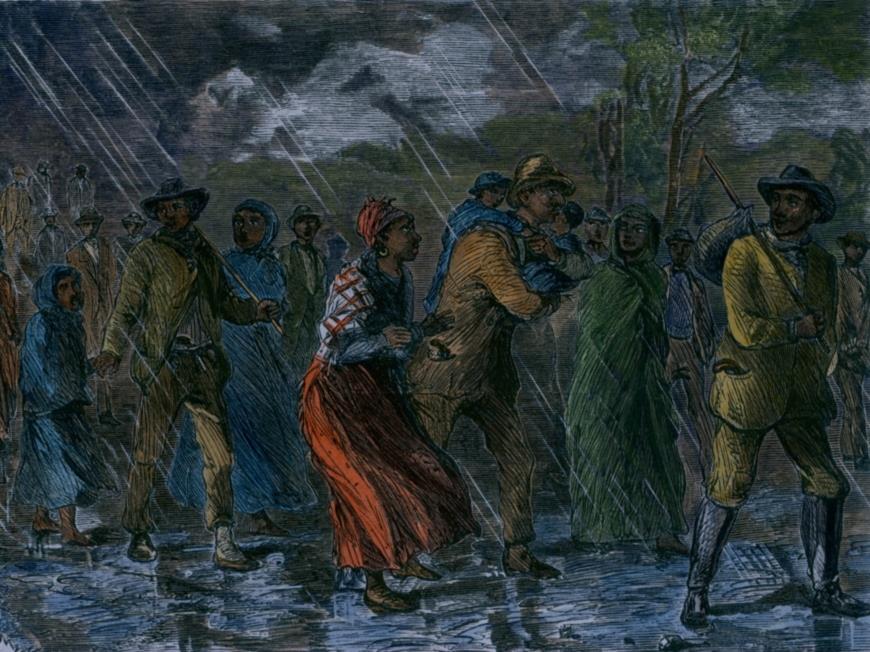
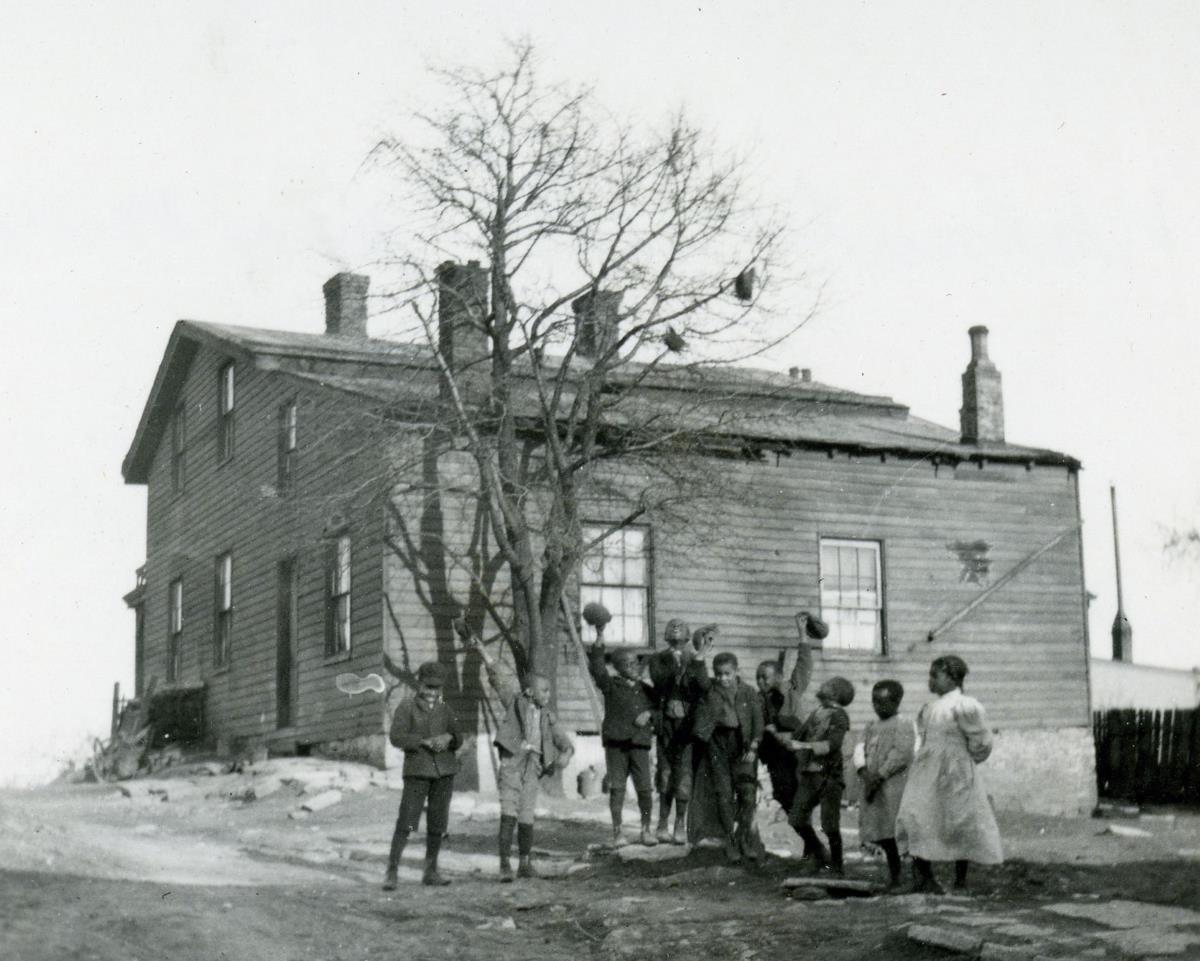
THE PASSING OF THE LAST OF
"THE GREAT TRIUMVIRATE"
Clay – June 1852 Webster – October 1852
The passing of the last of the Great TriumvirateWe have already noted that John Calhoun died in the very midst of the debate that ultimately produced the Compromise of 1850. But the other two members of the Great Triumvirate were soon to follow. The passing of these three greats marked the end of another era of American politics and the beginning of yet a new one as the country marched toward a violent split.
At the end of June 1852, the Great Compromiser Henry Clay passed from the American scene. He had served the country since first entering the U.S. Senate in 1806, then serving in House of Representatives from 1811, eventually becoming its speaker in three different sessions. He then became the secretary of state under John Quincy Adams and afterwards returned to the position of senator until his death. He had campaigned for the U.S. presidency in 1824 and again as candidate for the Whig Party (of which he remained leader for the rest of his life) in 1832 and 1844, though he lost all three elections.
In late October of that same year the third member of the Triumvirate, Daniel Webster, followed Clay into eternity. Another Whig, Webster was famous for his eloquent defenses of American nationalism and for his support of the American business class which he felt strongly held the greatest responsibility for the success of the new nation. Webster served in the House of Representatives for ten years, in the Senate for another nineteen years and served as U.S. secretary of state under presidents Harrison, Tyler, and Fillmore, occupying this position as of his death in 1852.
Both men worked hard to hold back the forces that wanted to divide the country over slavery. They both suffered sharp opposition from the most aggressive members of the extreme wings of the Southern Secessionists and the Northern Abolitionists. But they held strong at the middle. But the middle was already losing power by the time of their deaths. With their deaths there now was little to hold the two conflicting sides together.
|
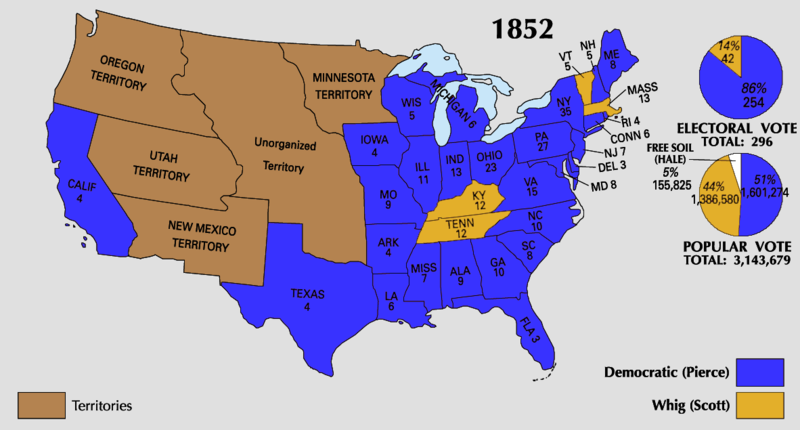
The Democrats nominated Franklin
Pierce of Vermont ... "a Northerner of Southern
principles" (whatever that actually meant) Pierce was a lawyer with an
acceptable military record as brigadier general in the Mexican-American
War (but wounded and thus not able to perform dazzlingly).
The Whigs (in major political disarray) nominated Gen. Winfield Scott
... whose strong Abolitionist principles were too advanced (at the
time) even in the North. This election ended the Whig Party. |
|
Franklin Pierce, the Young-America Expansionist, elected
The Whig Party was in major disarray. The Compromise of 1850 produced a deep sense of alienation by many Northern Whigs, who felt betrayed by some of their leadership, most notably the newly installed President Fillmore, whose support of the Compromise won him no affection from the anti-slavery branch of the Whig Party. On the other hand, the Democratic Party counted the Compromise as being a major success, especially by Southern Democrats because the Fugitive Slave Act clearly supported the Southern view of slaves as property rather than as humans. Also political moderates, both North and South, though not greatly fond of all the details of the Compromise, felt that nonetheless its passage had thankfully finally put the slavery issue to rest. The nation could now relax. In the Congressional midterm elections of 1850 that November, the Democrats swept the Whigs aside, securing two-thirds of the seats in the House. Sensing that they were headed for victory in the up-coming presidential election in 1852, the Democrats began immediately to prepare for it. Meanwhile the Whigs found themselves stunned by the huge 1850 setback. They were not sure which way to turn. Certainly there was no way they were going to support Fillmore in his bid for reelection. But who would they support? At the Democratic National Convention in 1852 the Democrats once again nominated (on the 49th ballot!) a Northerner of Southern principles: Franklin Pierce of Vermont – a lawyer with an acceptable military record as brigadier general in the Mexican-American War (but wounded and thus not able to perform dazzlingly). The Whigs responded with their own military hero as nominee, General Winfield Scott – whose Abolitionist principles at that point however were too strong for the taste of most Americans. Consequently, Scott and the Whigs were trounced in the 1852 elections, Pierce receiving a 50.8 percent of the popular vote (to Scott's 43.9 percent) and 254 electoral votes for Pierce versus Scott's forty-two. The Free-Soilers (4.9 percent of the popular vote) and other fringe parties (such as the Liberty Party and the American Party) made up the balance in the popular vote. Overall, this election began the decline and ultimate death of the Whig Party. It would dissolve before the next presidential election in 1856, with most Whigs joining the newly constituted Republican Party (no connection with Jefferson's former Republicans, however).
|
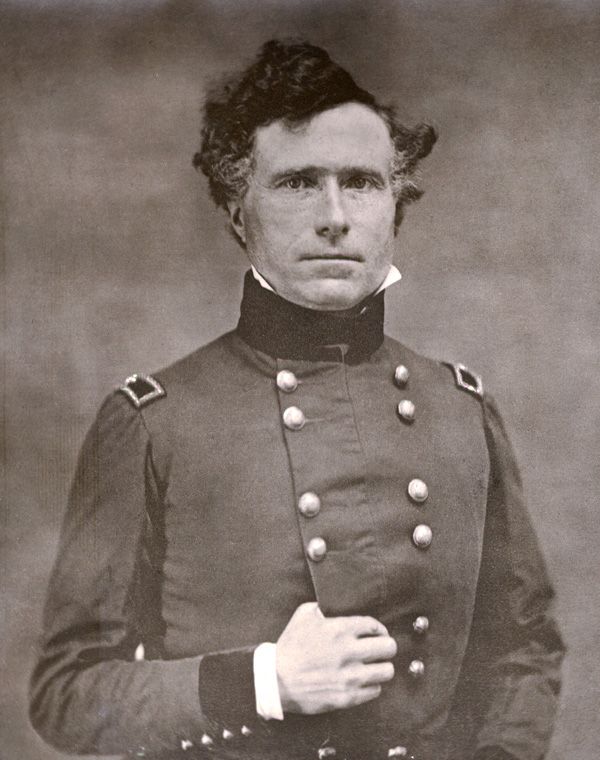
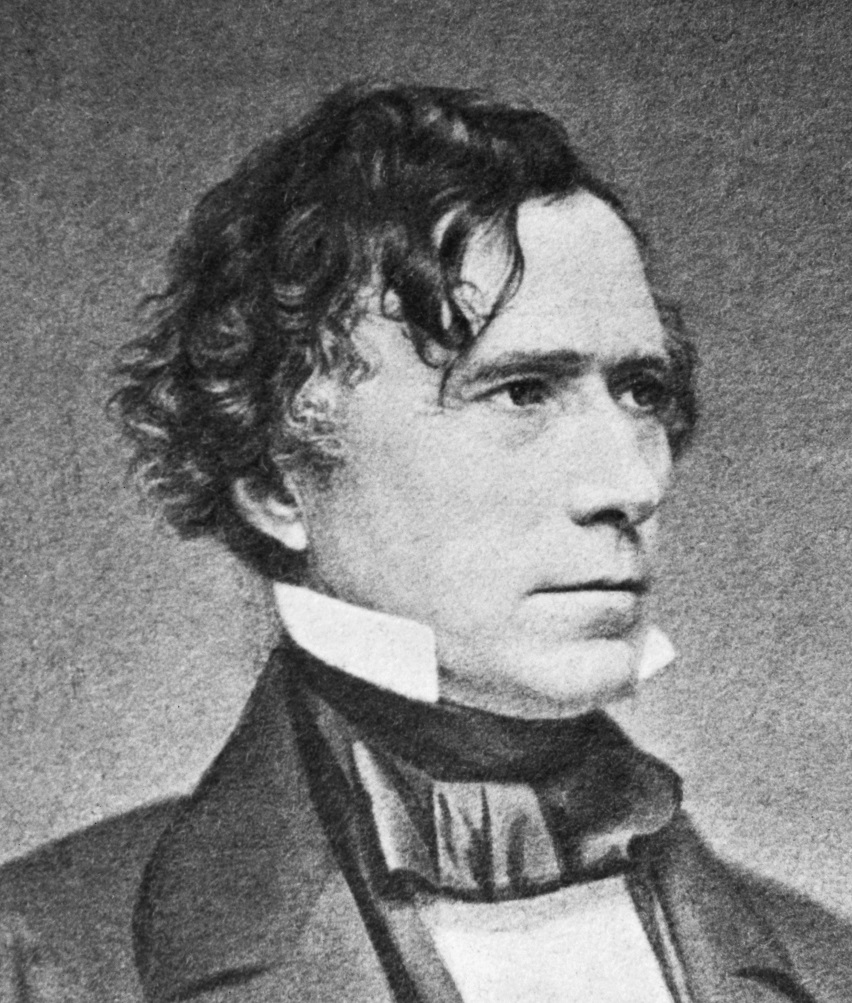

|
|
The Gadsden Purchase (1853)
By 1850 America had laid more railroad track than any other nation and over the next ten years the amount of track laid would more than triple. Most of this occurred in the North. But even the South by 1860 would have more track laid than any European country. It was during Pierce's presidency that his secretary of war, Jefferson Davis (soon to be president of the Southern Confederacy), began to push for a Southern railroad to reach all the way to the Pacific. This would have put the South ahead of the North in its reach West, possibly giving slavery a boost in the Western territories for which slavery was to be a local option chosen by the people of the territory themselves. Thus Davis convinced Pierce to send rail magnate James Gadsden to negotiate with Mexican President (again!) Santa Anna for the purchase of a section of Arizona border territory that would have helped the South more quickly reach its goal of a southern transcontinental railroad. The purchase price of this section of land (popularly termed the Gadsden Purchase) was for $10 million, badly needed by Santa Anna whose government was once again on the verge of bankruptcy. With this purchase, the territorial reach of the U.S. was complete (until a century later in the 1950s when Alaska and Hawaii were added as distant states).
|
| In 1853 Jefferson Davis (a leading Southern voice convinced President Pierce to send rail magnate James Gadsden to negotiate with Mexican President Santa Anna the purchase for $10 million of Mexican-American borderland, allowing the South to build its own railroad reaching all the way to the Pacific at southern California. |
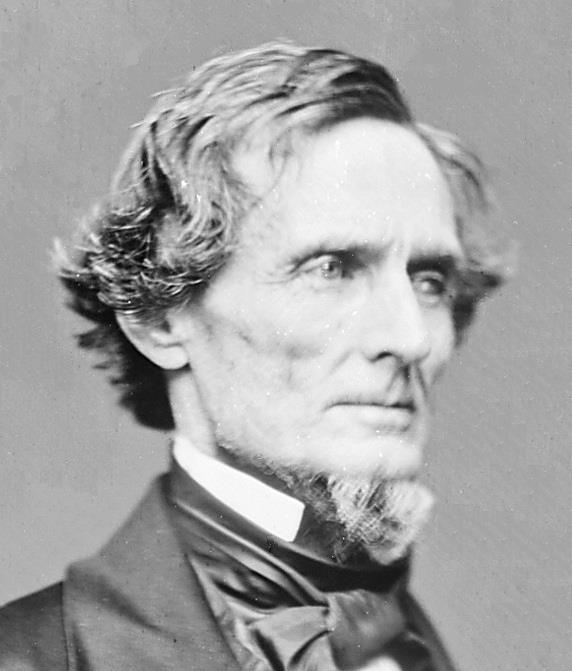
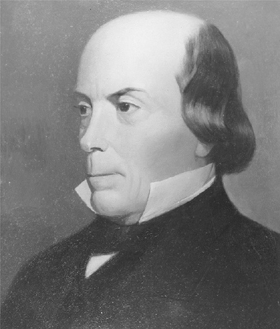
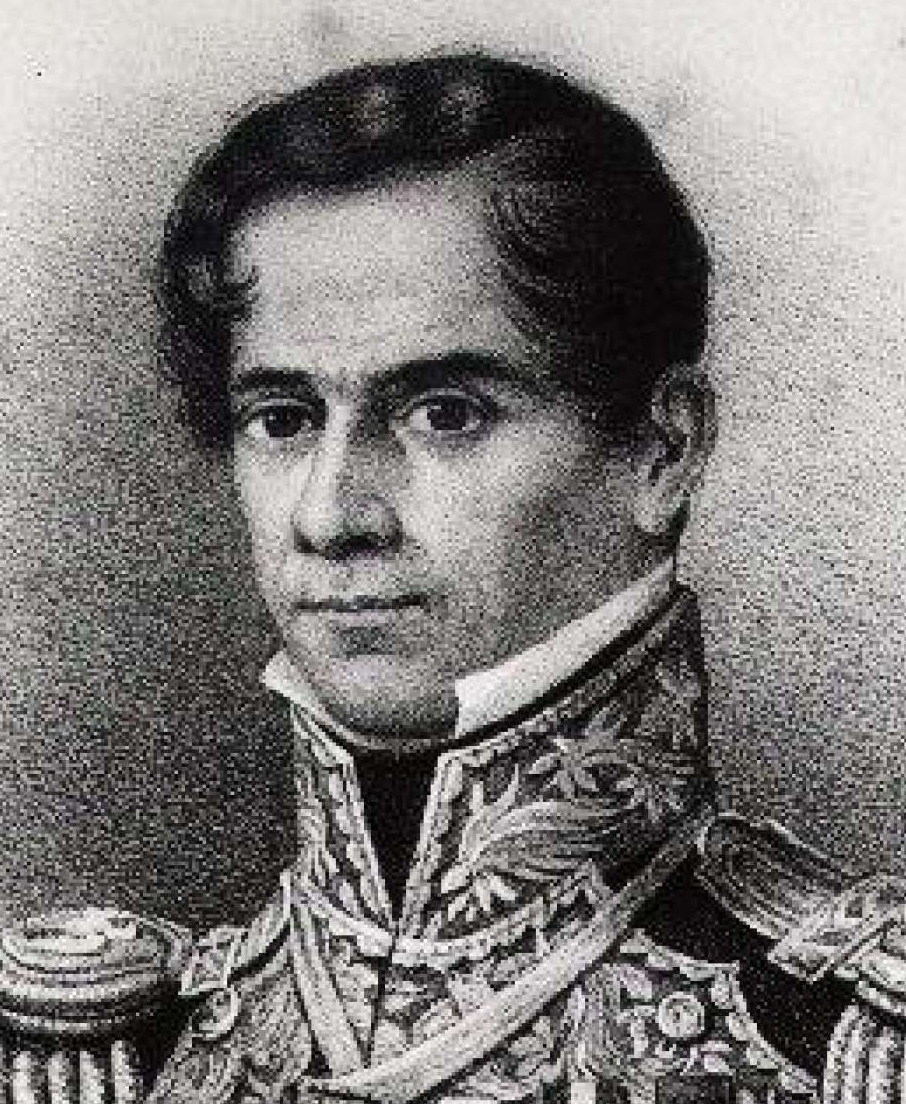
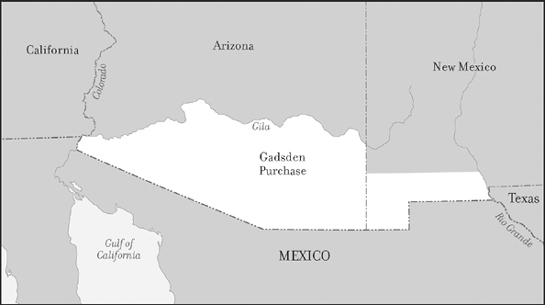
|
Cuba and the Ostend Manifesto (1854)
The island of Cuba, not far from the southern shores of Florida, was still held by a greatly weakened Spain, which however posed no particular threat to America and its Monroe Doctrine. Consequently, over the years it had attracted little American attention. However, following the admission of California to the Union and the unlikelihood of the New Mexico and Utah territories joining the Union as anything other than as Free-Soil states, the South turned its eyes to Cuba as a possible slavery territory and future state offsetting the North's gains. At the urging of Pierce's secretary of state, William Marcy, a meeting of American diplomats posted to Europe met secretly in Ostend, Belgium, to discuss a strategy for either purchasing Cuba from the Spanish, or just simply taking it by force. But news of the secret meeting got out, causing a huge outrage in both Europe and in the American North, and a major embarrassment to the Pierce government. The timing for this was terrible, because it coincided with another issue that was tearing the country apart.e
|
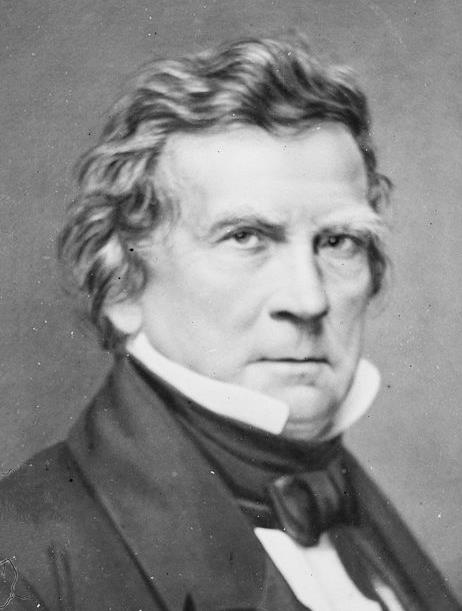
Secretary of State William L. Marcy
| Pierce's Secretary of State Marcy convinced the president to authorize a meeting in Ostend, Belgium, of American diplomats posted to Europe ... to plan a takeover of Cuba and adding it to the American Union as another Slave state. But news of the meeting got out ... causing a huge uproar and abrupt end to the plot. |

|
|
A combination of land hunger from American farmers being pushed West in search of new lands to open up, plus the commercial interests of railroad magnates seeking the riches that came with the land-for-rails exchange,3 put the huge Nebraska Territory just to the west of Missouri up for development. This of course brought forward the persistent question with reference to the Nebraska Territory: slave or free? According to the Missouri Compromise of 1820, the Nebraska territory, being entirely above the 36°30' line separating in the Western territories' Free-Soil land above that line and slavery territory below it, should automatically have been classed as a free state. But as some (notably Democrat Party leader, Illinois Senator Douglas) pointed out, California and New Mexico were well below that line and had entered as Free-Soil states under the principle of popular sovereignty (letting the state's citizens themselves decide the matter of slave or free). Indeed, Douglas made it a personal mission of his own to get Congress to accept this same principle of popular sovereignty for the new Nebraska Territory. Southerners joined with Douglas, and went even further in attempting to amend the bill by adding the provision making the Missouri Compromise now null and void. President Pierce, his cabinet and Southern Democrats were all highly favorable to this proposal. Even Southern Whigs supported the idea. But Northern Whigs were furious, and Northern Democrats were none too pleased. In all, the issue would finally finish off the Whig Party through an irreparable split in its ranks. But the Democratic Party would also find that its huge majority would mean little in Congress when it too was deeply split over this issue. Pierce attempted to hold the Democratic Party together by making support of the Nebraska Bill the measure of party loyalty and the distribution of party favors. He even proposed to pass responsibility over to the Supreme Court by getting it to declare the Missouri Compromise as unconstitutional. In January of 1854 the bill was reintroduced in the Senate, calling for the repeal of the Missouri Compromise and dividing the Nebraska Territory into two parts, Kansas to the south and Nebraska to the north. The new northern section of Nebraska was clearly going to be free territory, by the obvious choice of the settlers themselves. But the southern section of Kansas was understood as being capable of going either way in a popular vote. With Democrats possessing a large
majority in both houses of Congress and Douglas using all his energies
to gain passage of the bill, it finally passed both houses after four
months of bitter fighting, 37 to 14 in the Senate (early March) and 113
to 100 in the House (May 22), with Pierce signing it into law on May
30th. Despite Congress's resolution of the Kansas-Nebraska matter, the country as a whole was taking a position very different from that of Congress. The North, containing the vast majority of the nation's population, was distressed by the political slick that had just occurred in Washington, and was more determined than ever in its stand against the extension of slavery. The South, on the other hand, was not moved to a greater affection for the Union because of the new Act, becoming instead even more skeptical that union with the anti-slavery North was going to last much longer. 3Railroad
companies were given huge land grants in return for laying track in the
Western territories. The land then was sold to new settlers, to
compensate the railroad companies for their building expenses. It was
to the great advantage of the railroad companies to bring in as many
settlers as possible, pushing the rapid development of these
territories.
|
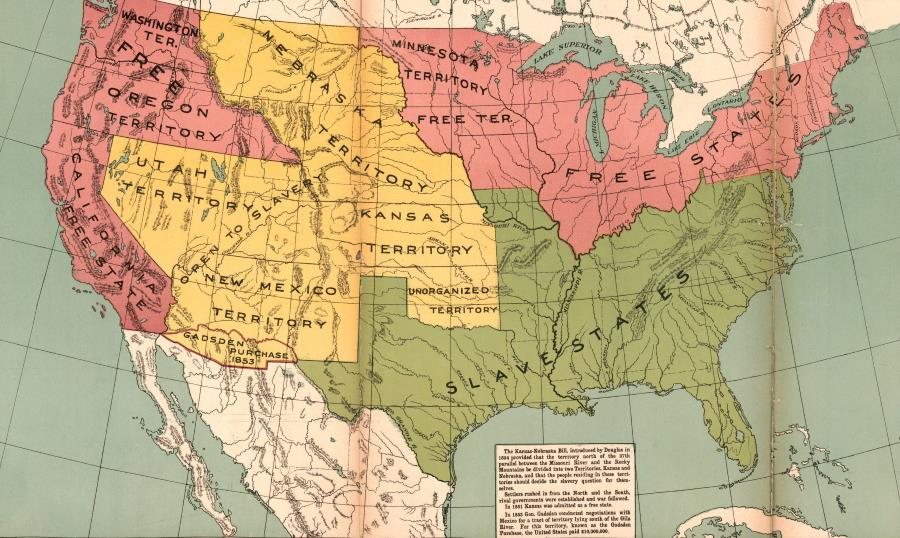
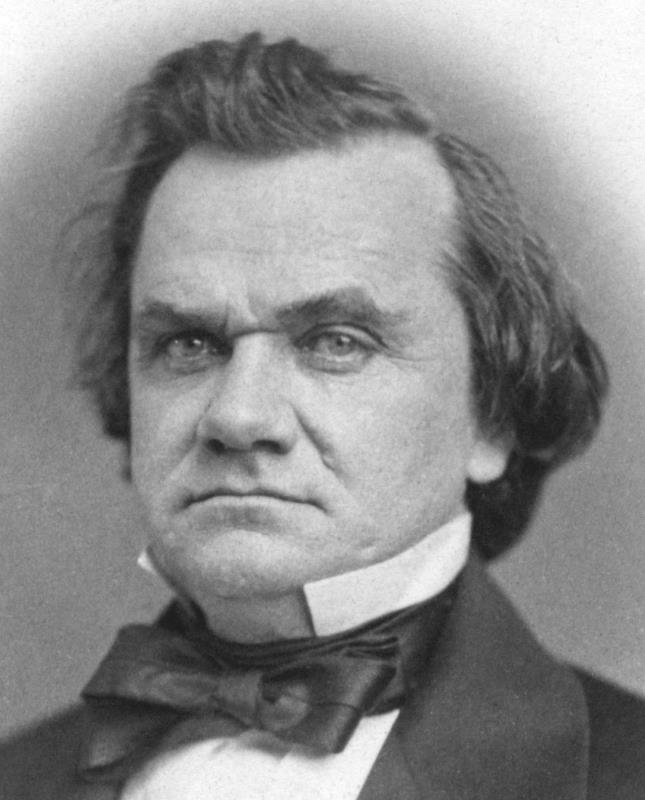
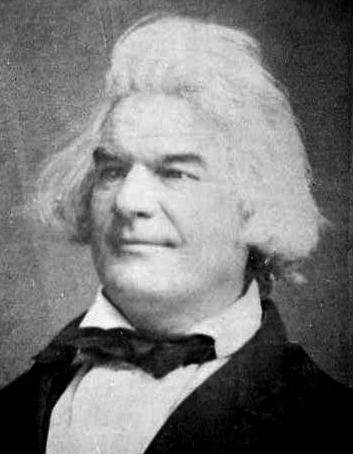
Co-authors of the Act setting aside the Missouri Compromise of 1820 calling
on the people of the territories themselves to decide whether Slave or
Free. But turning the decision over to the people would lead to bloody
rivalry between local parties. It would actually start the Civil War. |

|
|
In the elections of 1854, the Democratic Party experienced a huge setback delivered by its Northern constituents. Of the 91 Free-Soil or Free-State Democrats in the House at the time of the election, 66 of them were not reelected by their voters (mostly in New York, Ohio, Pennsylvania and Indiana), leaving only 25 Northern or Free-State Democrats to return to the House in 1855.4 They would fail to recover any of those lost seats in the upcoming elections. As a result, the Democratic Party turned itself into a heavily Southern Party. In all, six parties now competed in the House. A coalition of the American Party or Know-Nothings5 (52 seats) and the Opposition Party formed the new majority in the House. The American Party supported curbs on immigration, which voters felt were overwhelming the Anglo-Protestant character of America. For a while it looked as if the American Party might replace the Whigs as the main adversary of the Democrats. On the other hand, the Opposition Party was simply a loose coalition of the remaining members of the Whig Party (now holding only 15 seats), the Anti-Nebraska Party (22 seats), the People's Party (9 seats) and the new Republican Party (13 seats). This latter party, that of the new Republicans, would however soon absorb the last of the Whigs (and their political and economic philosophy) and the Anti-Nebraska Party. Also a large number of the American Party or Know-Nothings would accompany their leader, House Speaker and soon to be Massachusetts Governor Nathaniel Banks, in moving into the Republican Party. Thus the Republican Party, rather than the American Party, would move ahead to face the Democrats as the Democrats' major opponent. This would then form the Republican-Democratic Party dualism that exists to this day. 4As senators were still chosen by their state legislatures, the Senate profile changed very little in 1854. 5The American Party was built mainly on a number of fraternal lodges whose members operated under a pledge of secrecy (as was common in men's organizations at that time). When quizzed about their doings they responded with "I know nothing," thus acquiring their nickname as the "Know-Nothings."
|

|
|
Bleeding Kansas
With the Kansas-Nebraska Act's call for popular sovereignty in determining the future of Kansas, there was a push on by both Northerners and Southerners to increase the supporters among the Kansans of one side or the other. From Missouri came pro-slavery settlers (termed "Border Ruffians" by angry Free-Staters) to augment the ranks of those ready to vote for slavery for Kansas. But the Free-State side had their "Jayhawkers" who entered Kansas to build up the ranks of the free vote. Thus Douglas's popular sovereignty turned out to be not the solution Kansas needed to avoid conflict, but the very cause of its growing intensity. Conflict thus began to mount between the two groups, so much so that the strongly pro-slavery territorial capital at Lecompton became a very dangerous place for Free-Staters. This caused the Free-Staters in 1855 to establish their own legislature at Topeka and to elect their own governor and senators. Kansas newspapers chose sides and hyped the intensity of the bitterness mounting between the two parties. This in turn invited vigilante action in which one or another of these newspapers were ransacked and their presses destroyed.
|
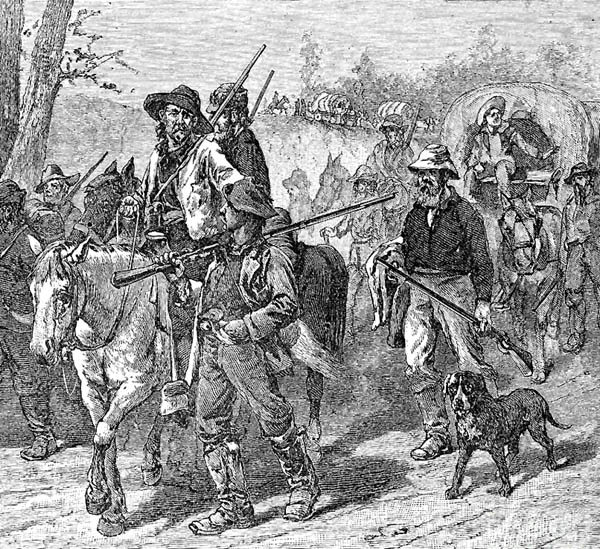
"Border Ruffians" entering Kansas to inflate the pro-slavery vote
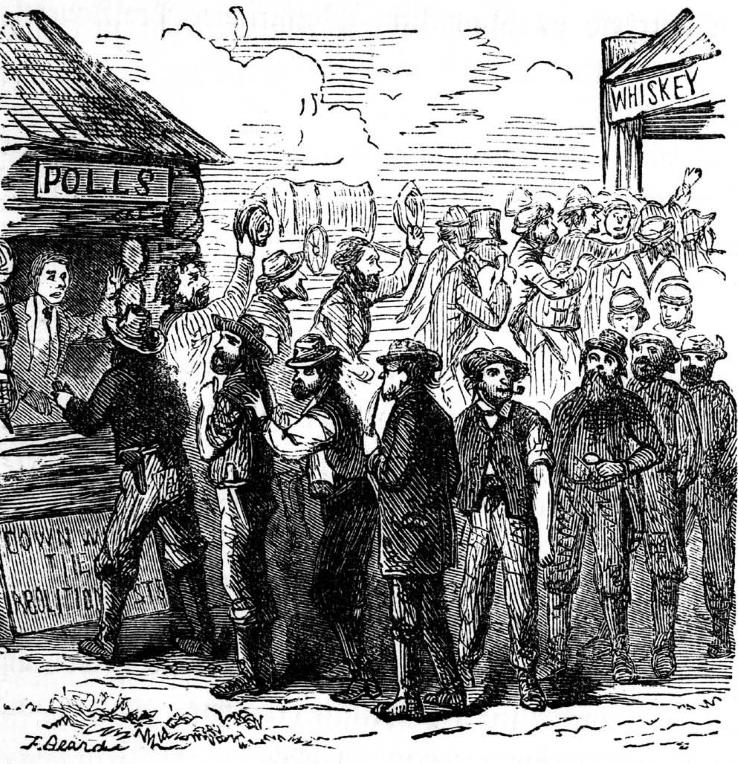
Pro-slavery Missourians voting in the Kansas elections
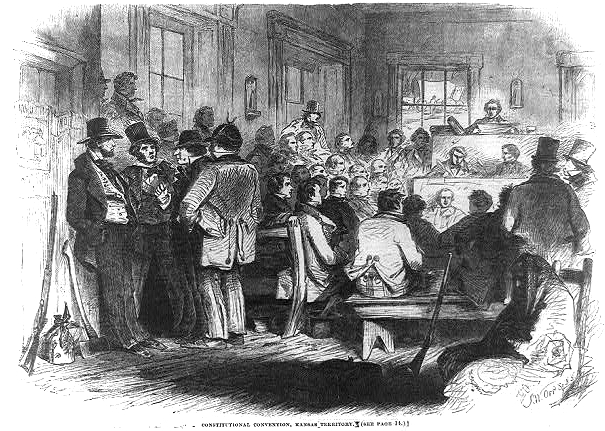
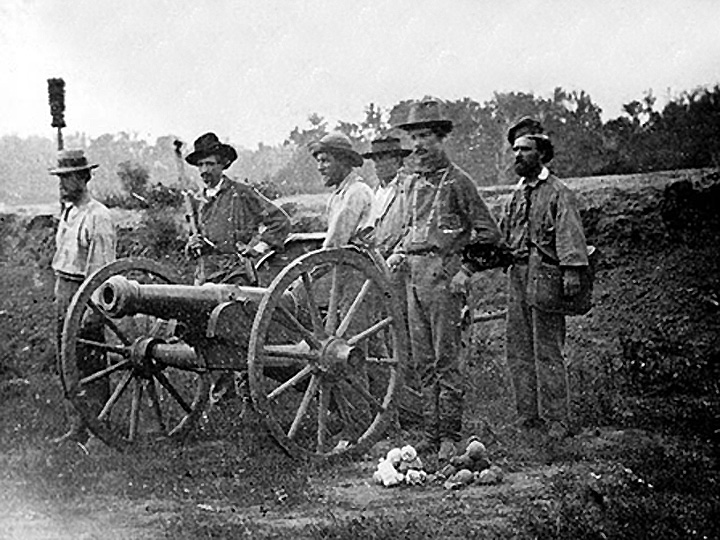
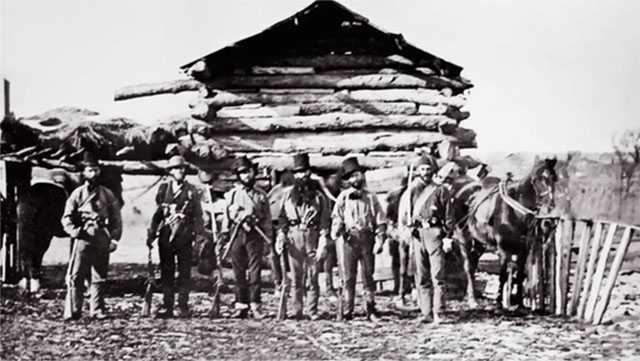
Photo presumed to be of "Jayhawkers" or Abolitionists in Kansas
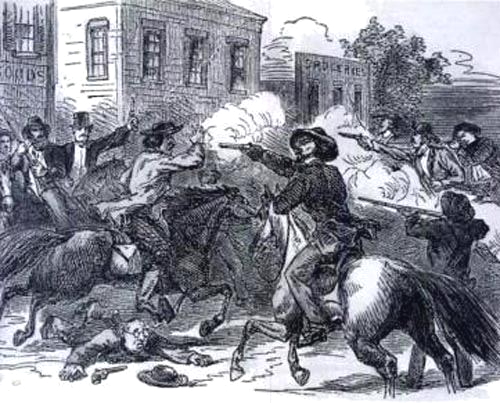
The Sacking of Lawrence
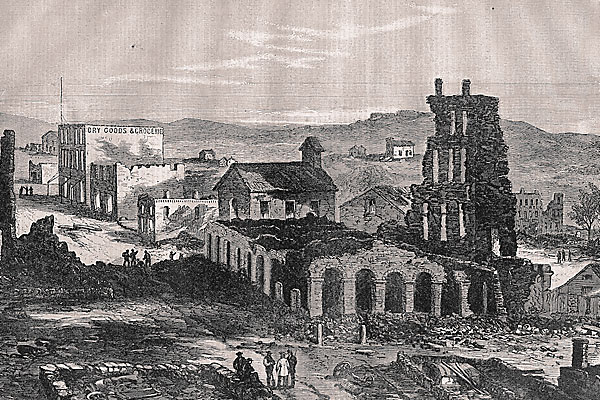
|
The Brooks caning of Sumner (May 1856)
While Kansas bled away, an incident occurred in the U.S. Senate that would add fuel to the growing fire. The strongly Abolitionist Massachusetts Senator Charles Sumner, who had a knack for delivering sharp insults, in his "Crime against Kansas" speech unloaded a stream of insults on the Kansas-Nebraska Act's coauthors, Douglas and South Carolina Senator Andrew Butler. Butler's cousin, South Carolina Congressman Preston Brooks, decided to avenge Butler's honor by entering the Senate and pounding Sumner nearly to death with a cane (requiring Sumner two years to recover), making Brooks a hero to the South and Sumner a martyr to Northern Abolitionists.
|
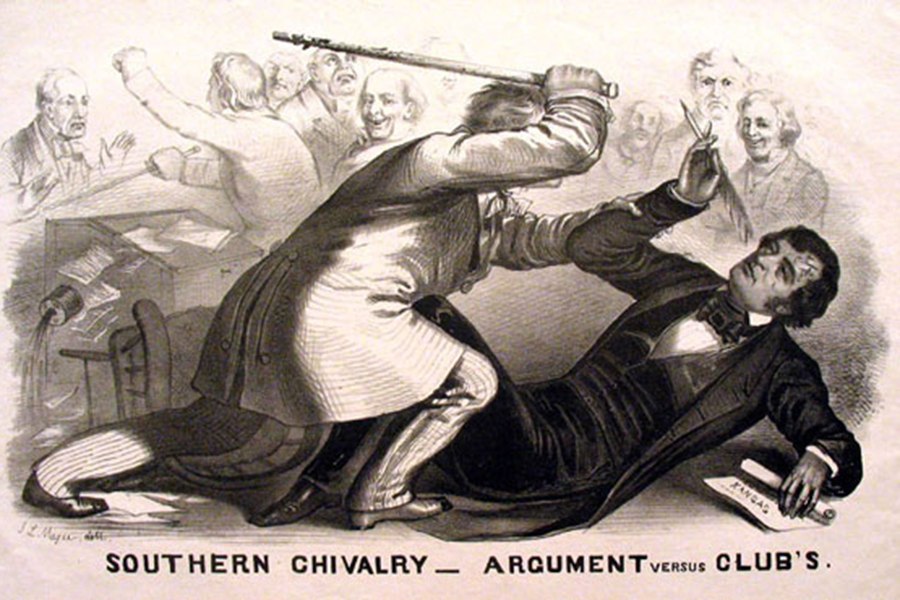
in the Senate chamber
New York Public Library
- Aster, Lenox & Tilden Foundations
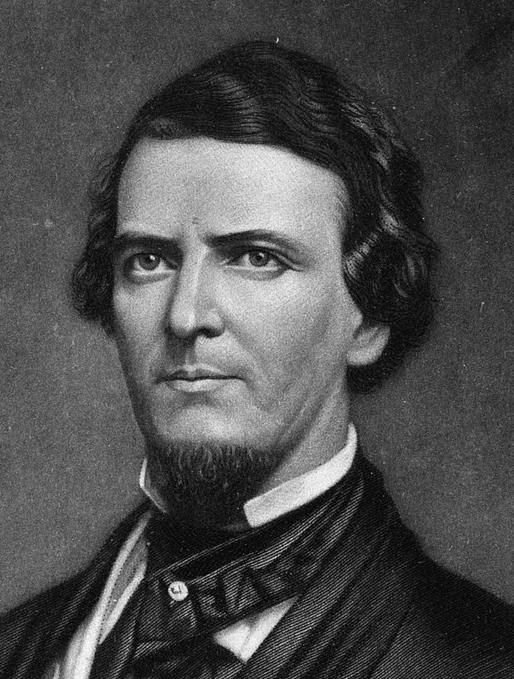
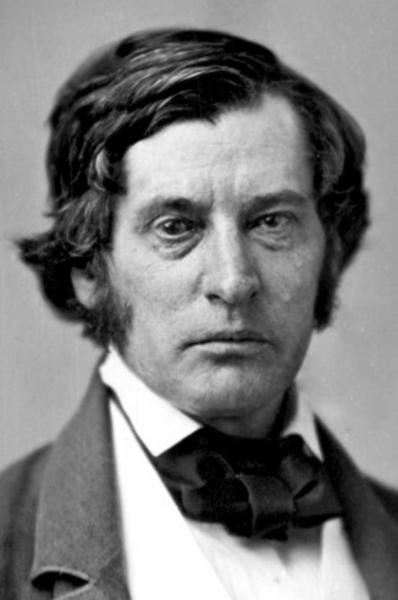
Preston Brooks Charles Sumner
|
John Brown and the Pottawatomie / Osawatomie Massacres At about the same time, the appearance of the wild (and possibly slightly insane) self-proclaimed Abolitionist leader John Brown and his sons, plus a handful of other followers, only heightened the violence in Kansas. In May of 1856 they executed five pro-slavery farmers in the Pottawatomie Massacre in revenge for the sacking of Lawrence by pro-slavery forces. In retaliation, in August several hundred Border Ruffians, equipped even with cannons loaded with grapeshot, attacked the town of Osawatomie, where Brown's family was living. With only 40 defenders as his support, Brown was forced to withdraw after having lost two of his sons and several other Free-Staters killed. Then the Border Ruffians proceeded to loot and burn the town. But John Brown would survive to become a central figure in the growing bitterness between the North and the South. From then on, the Kansas violence would only escalate into full scale guerrilla-style warfare, complete with the killing, looting, and burning of settlements and the destruction of crops across Kansas. Not only was Kansas bleeding, but in Kansas the Civil War had already begun. And Kansas would continue to bleed until the last shot of the Civil War was fired in 1865.
|
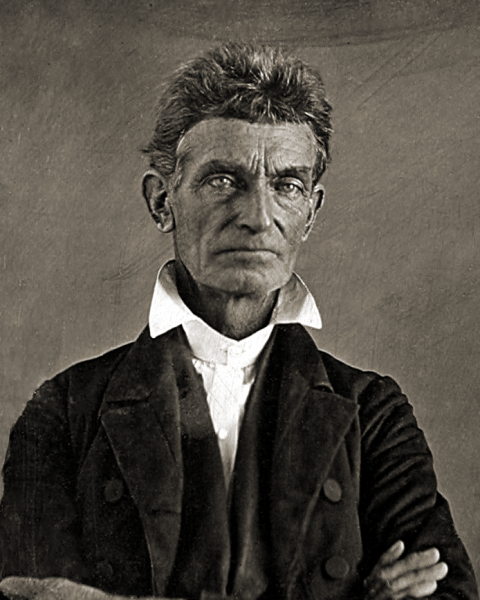
Boston
Athenaeum
The Massacre at Marais des Cygnes (Swan's Marsh) – May, 19, 1858
A pro-slavery group of 30 Missouri "border ruffians" captured 11 free-state men
at the village of Trading Post (Kansas) and marched them off to be executed.

|
|
James Buchanan elected (1856)
By 1856 the Republican Party was registering rapid growth, and ready to field its first candidate for the U.S. Presidency. Leading the organization were Ohio Senator (and soon-to-be Governor) Salmon P. Chase and New York Senator (and former Governor) William H. Seward. Although the Republicans took up the former Whig Party agenda of national banking, protection of industry, and infrastructure improvements (roads, canals, and railroads), the main issue they pursued was the issue of slavery. Though not radical (and thus demanding an immediate end of slavery), they were very much behind the idea that it was time to begin to put an end to slavery through financial compensation to slave owners and recolonization to Africa if necessary. But the Republicans passed over Seward as their presidential candidate, choosing instead California war hero John Frémont. However, in the national elections in November the Northern vote was split by the Know-Nothings who fielded former President Millard Fillmore as their own candidate. This split caused neither Frémont nor Fillmore to be elected. Instead the Democratic Party candidate, former Pennsylvania senator, U.S. secretary of state and ambassador to England, James Buchanan, won the election (45.3 percent of the popular vote for Buchanan, 33.1 percent for Frémont and 21.5 percent for Fillmore, though with 174 electoral votes for Buchanan, 114 for Frémont and only 8 for Fillmore).6 Buchanan had been in England during the Kansas-Nebraska crisis and thus was not identified strongly with either side in the issue. He intended to keep it that way, claiming that he alone at this point could bring healing to a disunited country. He would be above politics. Anyway, he was counting on the Supreme Court to settle the question of slavery in the territories. 6At
their National Convention, the Democrats had passed over their own
White House incumbent President Franklin Pierce to give Buchanan a
plurality, though not a majority, on the first ballot. Party leader
Stephen Douglas started out a distant third, then began to pick up
additional votes with each round of new party elections, at the cost of
Pierce. Finally Douglas threw his support to Buchanan, giving him the
party's nomination on the 17th ballot.
|
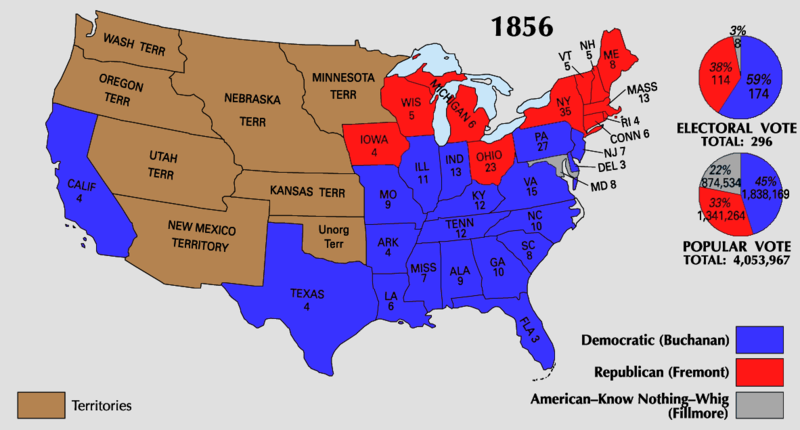
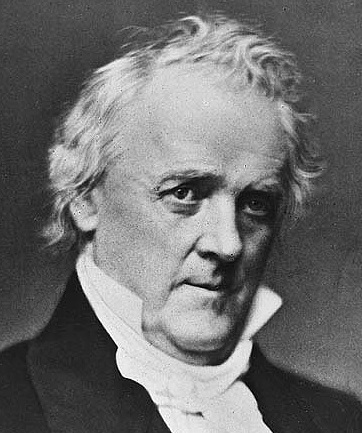
Library of Congress

|
|
And the decision of the Court came only two days after Buchanan's inauguration (early March 1857). The case concerned a Black man (Dred Scott) and his wife and their daughter, as to whether nor not under the law they had – because of their long residence in the anti-slavery North (before being brought back to pro-slavery Missouri) – attained the status of free citizens. It was in being shifted from owner to new owner as slaves that Scott decided to bring his situation to trial. He filed in the Missouri courts for recognition of his free status – whose jury initially agreed with him. But he lost that favorable decision on appeal by his owner Sanford. Scott filed the case again, Scott v. Sandford,7 this time in federal court, and his case made its way through appeals all the way finally to the U.S. Supreme Court. On March 6, 1857, Chief Justice Roger B. Taney issued the Court's 7-2 decision, finding against Scott and in favor of Sanford. Taney's findings were supposed to put the issue of the legality of slavery in the new territories to a final resolution. But in fact they did quite the opposite, deepening further the hostilities separating the free North and the slave South. Firstly, Taney said that since Scott was a slave and not a citizen, he had no right to bring suit against Sanford in a federal court. That should then have been the end of the legal issue for the Court. But Taney went on to touch further on the legal implications of the case. He claimed that Scott had no right to citizenship because no slave had the right to citizenship, because none of the slaves had origins as free citizens, even the ones who had received manumission (being freed) by their owners. He stated also that no states had the right to pass laws that offered manumission to slaves living within their jurisdiction. Further, Congress had no Constitutional right to make any determination of the slave or free status for any state or territory, as no such authority was given Congress by the Constitution. In fact the only relevant Constitutional provision in the matter was the Fifth Amendment which protects a citizen's property rights in all parts of the Union. Taney went so far as to affirm that no state had the right even to grant citizenship to Blacks, slave or free, because the Constitution was written only for the superior race of Whites. Blacks were unfit to associate with the White race and had no natural rights that Whites were bound to respect. Northerners were furious with the Court's ruling.8 Southerners were now no longer the only section of the country sensing that their values would have to be defended by force. The idea that Congress had no right to exclude the enslavement of men anywhere in the Union was too galling an idea to ever be accepted in the North. And at the rate of pro-slavery progress moving across the American political landscape, the states of the North could wake up to find themselves suddenly declared slave states by the Supreme Court. The moderate Senator Douglas did not challenge the Court directly, but stated that regardless of a territory's inability to exclude slavery, it could refuse to offer police enforcement or protection to the practice of slavery. But this piece of logic proved compelling to no one, Northerner or Southerner. Southerners now went so far as to claim that the Dred Scott decision had fully vindicated the practice of slavery, in any part of the Union. Some even claimed that it was time to go on the offensive and push to have slavery allowed in all the Union, therefore preserving the Union's integrity and unity in having no longer two but now one fundamental social vision (that of the slave culture of course). There was of course no way that Northerners were going to yield even an inch to that kind of argument. Thus overall, the Supreme Court's intervention in the sectional dispute only made things worse, pointing the nation ever more in the direction of armed conflict similar to the Kansas variety, except a violent conflict located in the very heart of the Union. 7The federal courts had misspelled the defendant's name, causing confusion in how to spell the name of the case all the way down to today. 8Nonetheless,
a previous owner of Scott paid for the freedom of Scott and his family
even as the Supreme Court's findings were being announced!
|
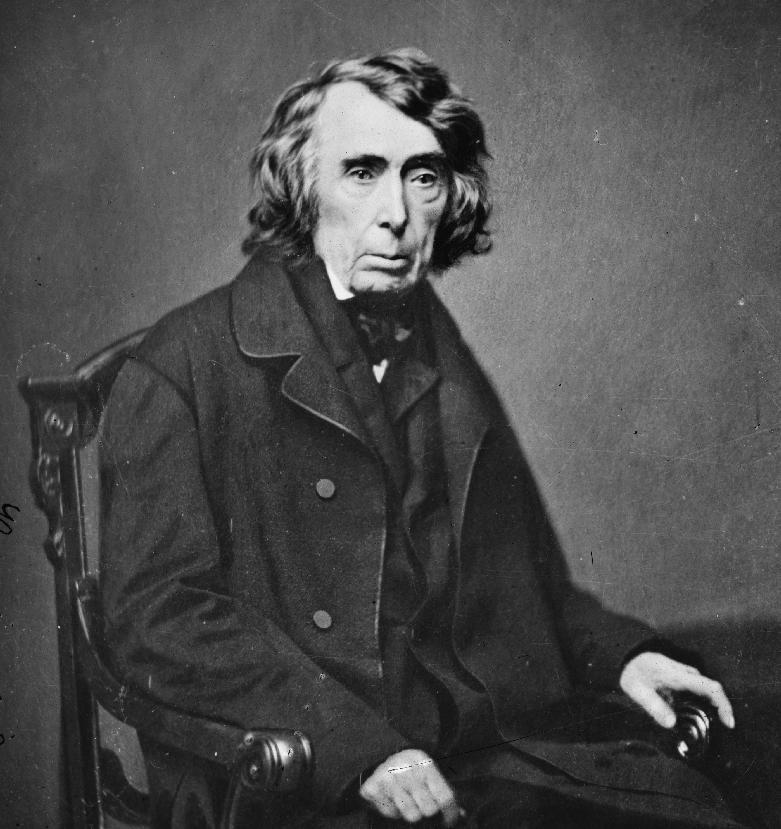
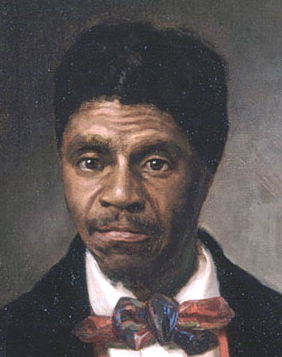
painting by Louis Schultze
(1882 – based on an 1857 photo)

|
|
On top of that, the Supreme Court decision put a huge chill on investment fever that had been pushing the fast-growing railroad industry westward at a frantic pace, dreaming of catching huge profits in the process. Suddenly the bubble burst as investors realized that the Dred Scott decision threw the future of Western development into question. Everyone was aware of the trauma of Kansas attempting to sort through the issue of slavery. Now it was clear that the Supreme Court had laid the same conditions for the rest of the Western territories. The decision as to whether a territory was going to be slave or free was no longer set by law, but by Senator Douglas' popular sovereignty, which meant by pitched battles between well-armed advocates of both sides. This was not a situation designed to invite economic development. Investors began to back out of the railroad enterprise (at least the railroads running West from the East, for North-South lines were not affected). Now the railroad companies could not pay off loans to Eastern banks, setting off a round of fears about the strength of the Eastern banks. Virtually overnight a huge financial panic set in in the North. The South experienced virtually none of this panic, presuming that it was because an agricultural economy based on the certainty of cotton sales was vastly superior to the highly speculative realm of the North's industrial capitalism. This only confirmed in the Southerners' minds the correctness of their (slave-based) agricultural society, which they were ready to defend to the death. And indeed, they would soon be called upon to do just that.
|
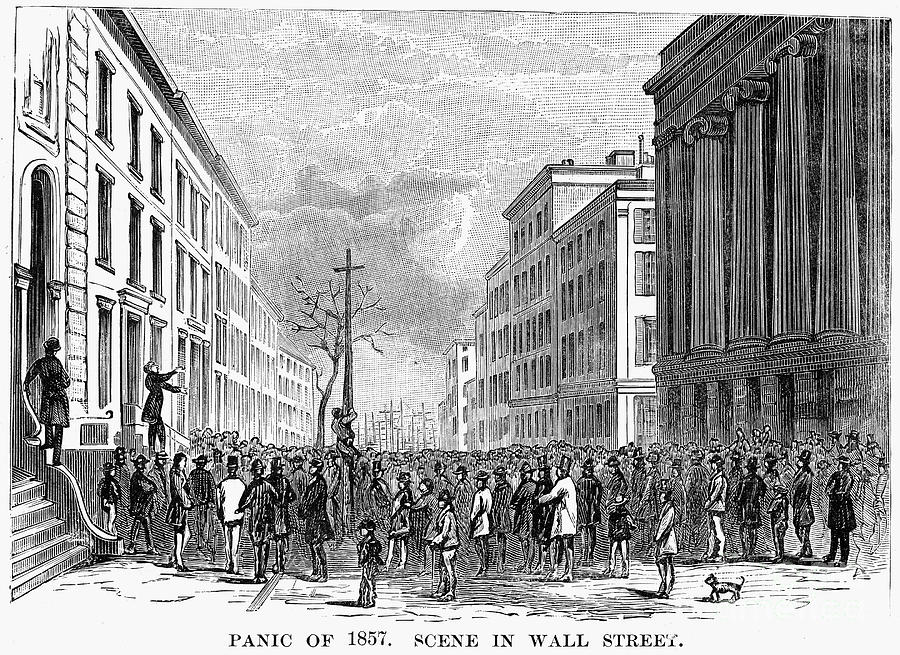
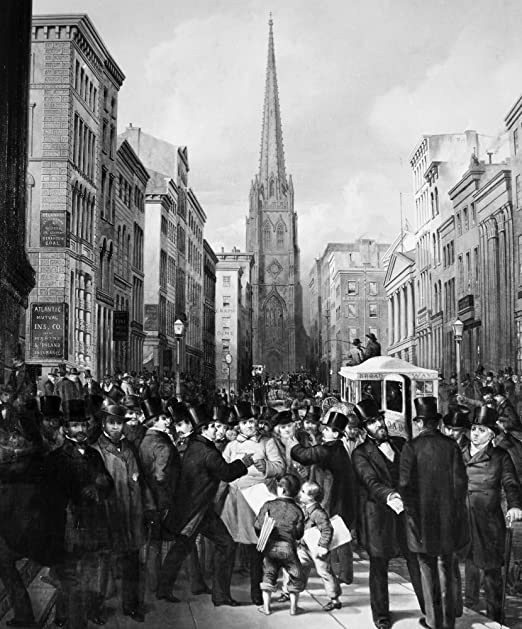

|
|
Meanwhile, John Brown had moved his abolitionist campaign East, and began plans to gather a small fighting force of his own to spark an uprising that he expected would be joined by hundreds of slaves throughout the South. The beginning of the uprising would be signaled by his attack on the U.S. military arsenal at Harpers Ferry, just up the Potomac River from Washington, D.C. But when the event occurred, only twenty men joined him, and a marine detachment under Colonel Robert E. Lee was immediately sent to the arsenal to put an end to Brown's rebellion. Ten of the raiders were killed on the spot, and Brown was wounded, captured, tried, and soon executed along with four other raiders. A few escaped and others were freed. The nation found itself deeply divided over this event. To the growing ranks of Northern Abolitionists, Brown was a great martyr whose efforts exemplified the noble qualities that had made the nation what it truly was, since the days of its own rebellion against English tyranny. But to Southerners he was viewed as an extremely dangerous villain, typical of all Abolitionists thirsting to destroy the South by inciting a massive and brutal slave rebellion.
Thus because of events such as Brown's raid on Harpers Ferry, the lines
of a coming war between the North and the South were clearly beginning
to be set in place.
|
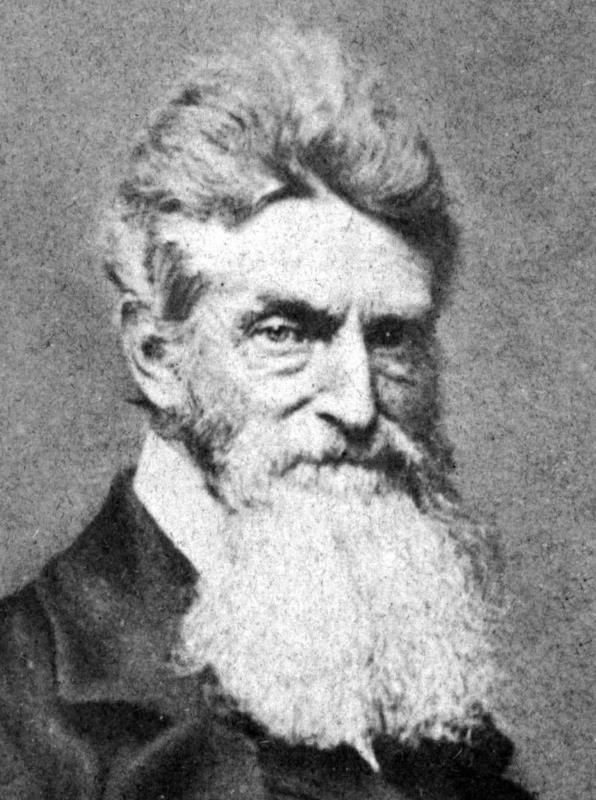
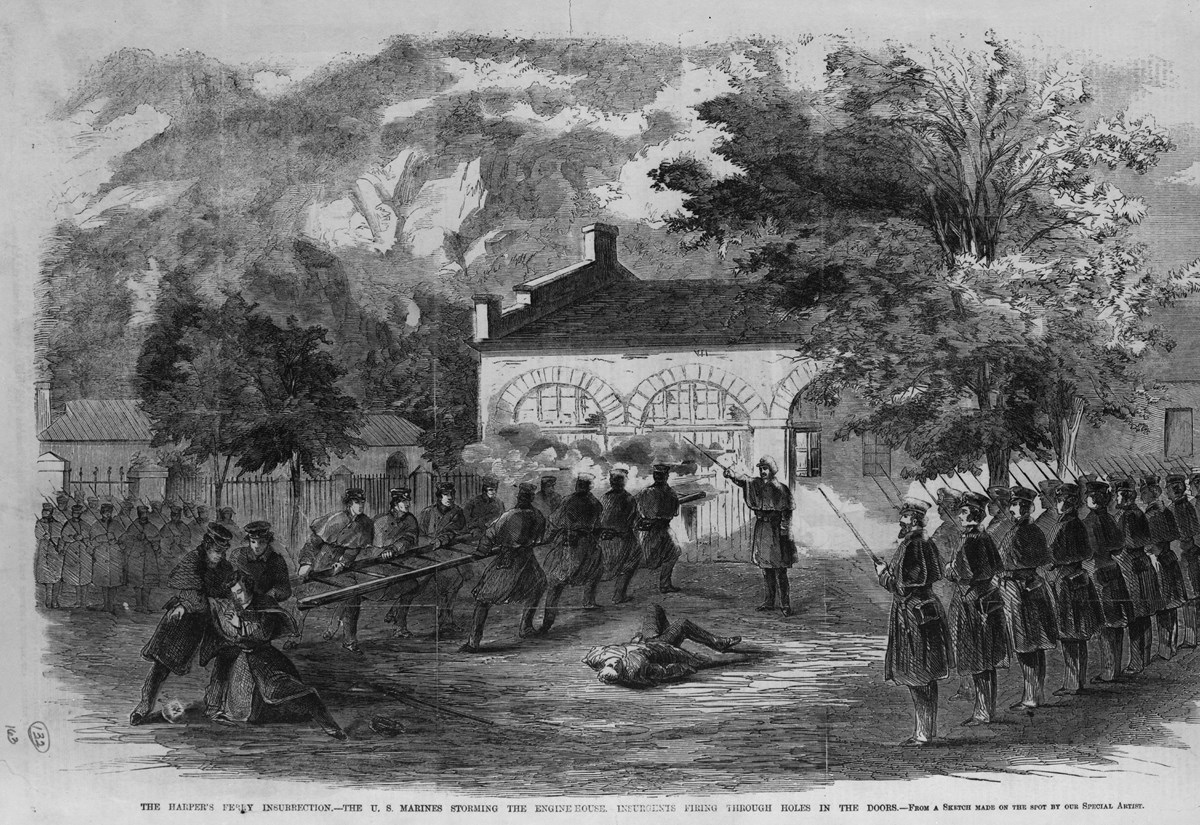
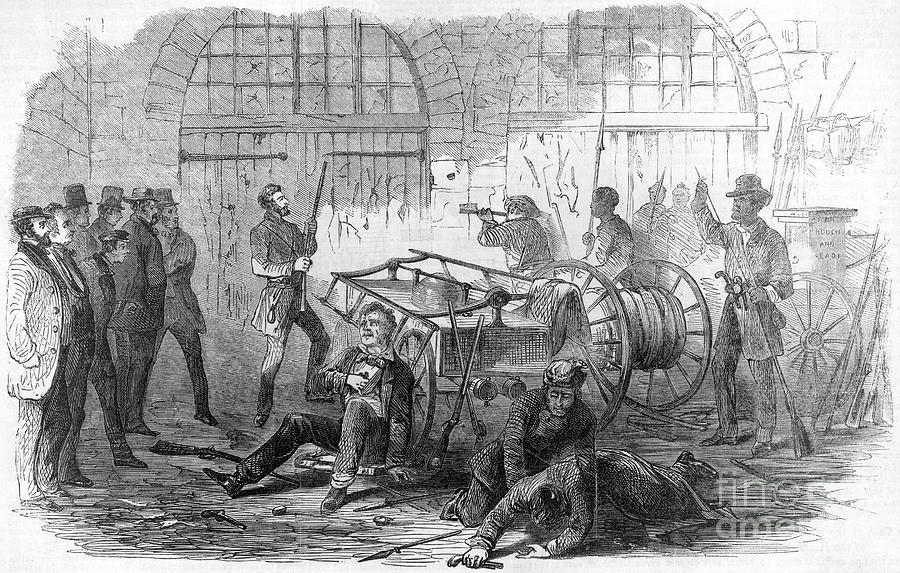
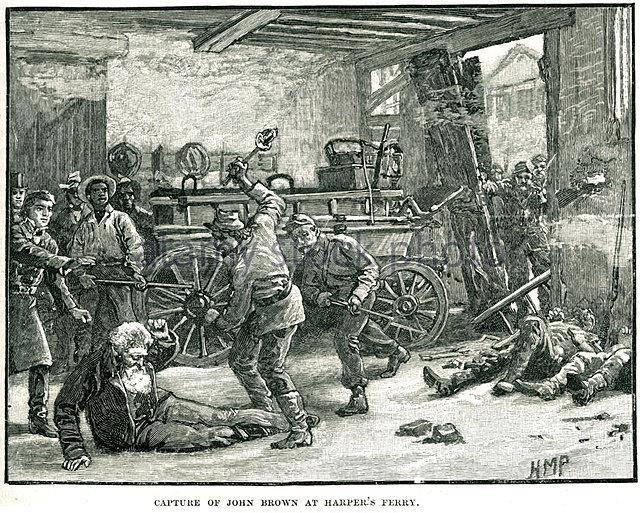
|
Statehood for Bleeding Kansas
To gain statehood, two different Kansas Constitutions were sent to Washington for approval, the Lecompton and the Topeka Constitutions, along with claims and counter claims involving massive fraud in the Kansas elections ratifying one or the other of these constitutions. Buchanan supported the pro-slavery Lecompton Constitution, whereas Douglas supported the Free-Soil Topeka Constitution. Eventually the Lecompton Constitution was defeated both by another referendum in Kansas (1858), and by a vote in Congress to admit Kansas as a free state, with yet another constitution, the Wyandotte Constitution of 1859. The latter vote in Congress in January of 1861 to admit Kansas as a new state occurred just as the nation was breaking apart, with the withdrawal of the Southern states from the Union.
|


 Miles
H. Hodges
Miles
H. Hodges